
-min.webp)
Measuring Mean Time to Respond (MTTR) in AI-driven SOC has become both more complex and more critical as artificial intelligence transforms how we detect, investigate, and respond to cyber threats. Traditional MTTR calculations often fall short when AI SOC Analysts are handling enrichment, initial triage and investigation, and even containment actions autonomously, creating new measurement challenges for security teams trying to benchmark their performance against industry standards.
The fundamental problem isn't just about tracking response times anymore, it's about understanding where human analysts add value in an AI-augmented workflow and measuring the effectiveness of that collaboration. When AI systems can investigate alerts in less than a minute and provide decision-ready reports, the traditional MTTR clock starts ticking differently, and security leaders need new frameworks to capture the full picture of their operational efficiency.
Mean Time to Respond represents the average duration from when a security event occurs to when it's fully contained or resolved. In traditional SOCs, this metric captures the entire human-driven workflow: detection, acknowledgment, investigation, and remediation. However, AI-driven SOCs introduce autonomous capabilities that can compress or eliminate certain phases entirely.
The key distinction lies in understanding that MTTR in AI environments often measures human decision-making time rather than pure investigative work. When AI SOC analysts can gather evidence, correlate indicators of compromise, and produce comprehensive reports within minutes, the bottleneck shifts to human review, approval, and execution of remediation actions.
{{ebook-cta}}
Traditional MTTR calculations typically include Mean Time to Acknowledge (MTTA), which often represents the largest bottleneck in SOC efficiency. AI eliminates this bottleneck by investigating alerts the moment they're generated, but introduces new measurement considerations:
A comprehensive MTTR measurement in AI-driven SOCs should capture the end-to-end process while distinguishing between automated and human-driven components.
The most effective approach involves breaking MTTR into distinct phases that reflect your AI SOC's actual workflow. Start with these core measurements:
Beyond core timing metrics, several indicators provide crucial context for MTTR performance:
Effective MTTR measurement requires integration across your AI SOC platform, SIEM and other alert generating tools, and ticketing systems. Establish clear timestamp collection at each workflow phase:
High false positive rates, whether from AI or the detection tool, directly impact MTTR by consuming analyst time on non-threats and reducing confidence in AI recommendations. Focus on these optimization areas:
The most effective AI SOC implementations optimize the handoff between automated analysis and human decision-making:
Mean Time to Respond (MTTR) represents the average duration from when a security event occurs to when it's fully contained or resolved. In traditional SOCs, this metric captures the entire human-driven workflow: detection, acknowledgment, investigation, and remediation
AI SOC Analysts can dramatically reduce MTTR—often by several multiples—by eliminating dwell time, accelerating investigation, and even automating containment or remediation actions.
MTTR in AI-driven SOCs is calculated from alert generation to threat containment, but should be broken into phases: AI investigation time, human review and decision time, and automated or manual remediation time. This provides visibility into where bottlenecks occur and optimization opportunities exist.
MTTA (Mean Time to Acknowledge) measures the time until an analyst begins investigating an alert, while MTTR measures the complete response cycle to containment. In tightly integrated environments, AI SOC Analysts begin investigations immediately, effectively eliminating MTTA in many cases., but MTTR remains relevant for measuring the full response process including human decision-making and remediation.
False positives increase MTTR by consuming analyst time on non-threats and reducing confidence in AI recommendations, leading to longer human review times. High false positive rates also create alert fatigue, potentially causing analysts to miss genuine threats or take longer to validate AI findings.
Key complementary metrics include Mean Time to Detect (MTTD), AI confidence scores, escalation rates, false positive/negative rates, and incident classification accuracy. These provide context for MTTR performance and help identify specific areas for improvement in your AI SOC implementation.
Get Gartner's guidance on evaluating and adopting AI SOC agents

